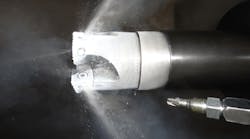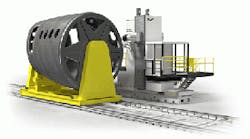Industrial-gas technology group Air Products is licensing its proprietary cryogenic machining technology to MAG IAS LLC, meaning that the CNC machine builder will use Air Products’ delivery technology and intellectual property for cryo-machining. Cryo-machining uses gas to “super cool” cutting inserts, mitigating heat generation during cutting and making it possible to increase cutting speeds, and also prolonging tool life.
The gas supplier noted that MAG would be deploying its own Minimum Quantity Cryogenics technology, in addition to Air Products’ cryogenic machining technology. MAG’s MQC was demonstrated at IMTS 2012, and is now available as an option on new MAG machines or in retrofit kits for existing MAG machines.
MQC delivers liquid nitrogen at -321°F (-196°C) through the spindle, directly to the tool tip and cutting zone. It makes it possible for machinists to increase process speeds and lower cutting forces, achieving longer tool life and generating less heat in the process. Recently, it was approved for U.S. Dept. of Defense contractors processing titanium components for the F-35 Lightning II stealth fighter (the Joint Strike Fighter program headed by Lockheed Martin Aeronautics.)
MAG noted that MQC is also eco-friendly, yielding dry chips and releasing no coolant mist or greenhouse gases.
According to Michael Judge, MAG vice president of Cryogenic Business Development, MQC's effectiveness based on the technique for plumbing liquid nitrogen through the insert to create a ‘heat-sink effect,’ rather than traditional chip zone cooling with wet coolants.
"Cryogenic machining has never been done this efficiently before, with liquid nitrogen passed through the spindle and through the insert," Judge stated. "Through-tool cooling provides the most efficient heat transfer model and consumes the least amount of liquid nitrogen, with flow rates as low as 0.08 liters per minute per cutting edge."
George Georgiou, MAG Cryogenics Engineering & Product Managerhas reported that MQC tests achieved a 60% increase in speed while milling CGI with carbide, and up to four times using PCD (polycrystalline diamond) tooling. "With the addition of Minimum Quantity Lubrication, we tripled speeds with carbide,” Georgiou said. “We have focused on higher material removal rates, while keeping tool life equal to what would be achieved with conventional wet coolants. Results indicate this technology dramatically improves the lifecycle cost for cutting difficult-to-machine materials by reducing the required number of machines and associated plant infrastructure, or possibly increasing tool life beyond anything thought possible today. Cryogenic machining becomes even more competitive when you consider it's a 'green' technology. There is no coolant mist collection, filtration, wet chips, contaminated workpieces or disposal cost, and certainly less energy consumption without all the pumps, fans and drives that go into handling coolant."
Air Products' ICEFLY technology
Now, MAG will be offering another option for cryo-machining: Air Products’ ICEFLY technology. “The technology license agreement grants global rights for the MAG family of branded equipment,” according to Jeffrey Knopf, Air Products ‘manager for Licensing and Technology Transfer. Along with supplying atmospheric, process and specialty gases, Air Products develops cryogenic applications based on its practical experience with low-flow cryogenic techniques for metals processing.
ICEFLY cryogenic machining cools cutting tools during processing of difficult materials, such as hardened steels and irons, thermal spray coatings, weld overlays, metal matrix composites, and powdered metals. The developer explained that by replacing dry machining or standard emulsion coolants with a small stream of liquid nitrogen (LIN), ICEFLY cryogenic machining can cool the cutting insert more effectively, to prolong tool life and raise cutting speeds, as well as to provide a clean work environment.
The process can be adapted to a range of automated or semi-automated machining operations, Air Products noted. In a published example, Air Products described how the ICEFLY machining system “jets” liquid nitrogen onto the cutting tools during the machining of powdered metal parts. Because of the excellent cooling effect of liquid nitrogen versus conventional coolants, tool strength and tool life were improved, and thus harder, more abrasive materials may be machined, and machining may be done at higher speeds.
Moreover, the cutting performance that is made possible by liquid nitrogen made it possible to eliminate several standard process steps in powder metal part processing, including pre-sintering, cleaning and draining, sintering, and quenching and tempering. The typical eight-step process for producing a finished part is replaced by three steps: compaction, sinter hardening, and machining.








